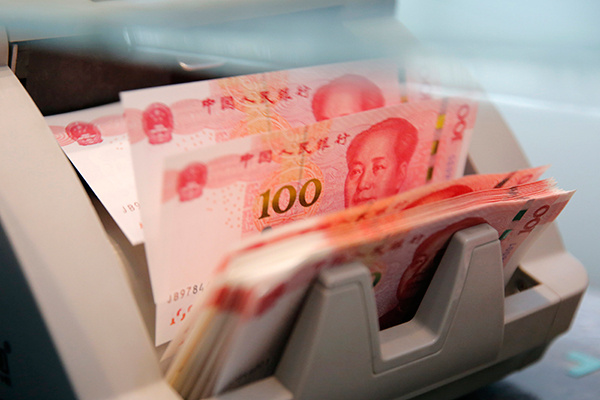
Chinese 100 yuan banknotes are seen in a counting machine at a bank in Beijing, China, March 30, 2016. [Photo/Agencies]
Commercial banks and insurers have got the green light from the regulators recently to trade Treasury bond futures, enabling them to better hedge interest rate risks amid the novel coronavirus epidemic, which has caused sharp volatility in global financial markets.
A Treasury bond is a government debt security that earns interest until maturity, at which point the owner is also paid a par amount equal to the principal.
Banks and insurance companies are normally the big buyers of Treasury bonds, holding more than 60 percent of China's Treasury bonds. Until now, they did not have access to the bond futures market to hedge risks for their exposure in the interest rates market as bond yields have been trending down globally, putting more pressure on their asset returns.
The move by the regulators will give them more tools to manage their bond holdings amid the low interest rate environment and will help promote a healthy development of the country's bond derivative market, according to a recent joint statement by the central bank, the Ministry of Finance and the securities, banking and insurance regulators.
The five major State-owned banks will be among the first batch of financial institutions to gain permission to participate in Treasury bond futures trading. As of January, Chinese commercial banks held Treasury bonds worth about 10 trillion yuan ($1.42 trillion) while insurance companies own about 360 billion yuan of central government notes.
It is estimated by industry experts that banks' and insurers' participation will bring an additional 40 billion yuan into the Treasury bond futures market.
Analysts said that trading Treasury bond futures will allow banks and insurers to effectively manage interest rate risks as their operations have seen rising challenges amid the low interest rate environment. They added that bond futures will provide an important trading strategy for banks and insurers and help maintain the overall stability of the country's financial system.
Globally, the total outstanding value of bonds with negative interest rates reached about $17 trillion as of September, according to a report by the Bank for International Settlements. China's interest rates have also trended down as the central bank has been cutting rates to shore up growth amid the epidemic.
"In a low interest rate environment, the yields of fixed-income assets will decline and some insurers could face the situation where their asset returns fail to cover the costs. If financial institutions can only adjust their portfolios in the spot markets, it will cause sharp volatility in the markets," Liu Xuan, head of the CFFEX Institute for Financial Derivatives in Beijing, said in a research note.
Dong Dengxin, director of the Finance and Securities Institute at Wuhan University of Science and Technology, said that allowing banks and insurers to trade Treasury bond futures marks an important development in China's financial derivatives market.
"It will boost the liquidity of the Treasury bond futures market and help improve the yield curve which will better reflect the real market prices," Dong said.
"It will also enrich risk management tools for banks and insurers. The institutions have been using short-term interest rate swaps to hedge risks, but there has been a lack of long-term risk management tools," he said.
Chen Li, head of research at Chuancai Securities, said that banks' and insurers' participation in the Treasury bond futures market is an example of China's capital market becoming more mature and more in line with international practices as Treasury bond futures have been a standard and important tool in developed markets.


